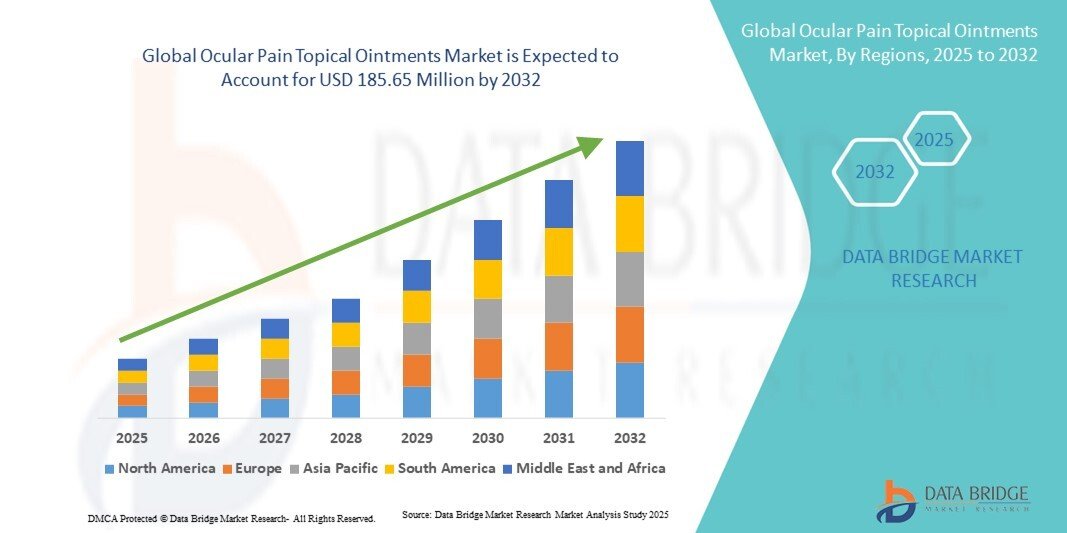Introduction
Ocular pain, often described as discomfort, burning, irritation, or outright sharp pain in the eyes, is a symptom that affects millions of people worldwide. From common conditions such as dry eye syndrome to more serious issues like corneal abrasions or infections, ocular pain can interfere significantly with daily activities. While treatment depends on the underlying cause, topical ointments are frequently prescribed or recommended as part of symptom management.
Definition
Ocular Pain Topical Ointments are medicated creams or gels applied directly to the eye or its surrounding tissues to relieve pain, inflammation, or discomfort. They typically contain anesthetic, anti-inflammatory, or lubricating agents designed for localized action, providing targeted symptom relief while minimizing systemic side effects. These ointments are commonly used for conditions like eye injuries, post-surgical recovery, or chronic eye irritation.
Understanding Ocular Pain
Ocular pain can arise from a variety of sources, ranging from superficial irritation to deeper structural or neurological issues. Some of the most common causes include:
- Dry Eye Syndrome – A chronic condition where inadequate tear production or poor tear quality leads to dryness, burning, and discomfort.
- Blepharitis – Inflammation of the eyelids, often due to bacterial buildup or dysfunction of the oil glands, causing irritation and soreness.
- Corneal Abrasions or Ulcers – Surface scratches or open sores on the cornea can be extremely painful and require immediate attention.
- Infections – Bacterial, viral, or fungal infections can cause sharp or aching pain along with redness, swelling, and discharge.
- Post-Surgical Recovery – Procedures like LASIK, cataract removal, or corneal transplants often leave patients with temporary ocular discomfort.
- Allergies – Seasonal or chronic allergic conjunctivitis can produce itching, pain, and swelling.
Because pain is a non-specific symptom, accurate diagnosis by an eye care professional is essential before beginning any treatment.
What Are Ocular Topical Ointments?
Topical ocular ointments are semi-solid preparations applied directly to the eye’s surface or eyelid margins. Unlike eye drops, ointments are thicker, adhere longer to the ocular surface, and provide prolonged relief. They typically come in small sterile tubes and are applied by gently squeezing a thin strip into the lower eyelid.
Ocular ointments serve various purposes:
- Lubrication – To protect the cornea from dryness and friction.
- Antibiotic/Antiviral Action – To treat infections directly at the site.
- Anti-Inflammatory Support – To reduce swelling, irritation, and pain.
- Healing Promotion – To create a protective barrier that aids in recovery from injuries.
Types of Ocular Pain Topical Ointments
1. Lubricating Ointments (Artificial Tears in Ointment Form)
- Uses: Primarily for dry eye syndrome, nocturnal lagophthalmos (inability to fully close the eyelids), and general irritation.
- Examples: White petrolatum, mineral oil, lanolin-based ointments.
- Benefits: Provide a moisture seal, reduce friction, and give long-lasting comfort, especially at night.
- Limitations: Can cause temporary blurred vision due to their thick consistency.
2. Antibiotic Ointments
- Uses: For bacterial infections (e.g., bacterial conjunctivitis, corneal abrasions at risk of infection, blepharitis).
- Examples: Erythromycin, Bacitracin, Tobramycin.
- Benefits: Act directly at the site of infection, reducing pain, redness, and risk of complications.
- Limitations: Ineffective for viral or fungal infections; potential resistance if overused.
3. Antiviral Ointments
- Uses: For viral infections such as herpes simplex keratitis.
- Examples: Ganciclovir gel, Acyclovir ointment.
- Benefits: Target viral replication directly on the cornea and conjunctiva.
- Limitations: Require strict dosing schedules; not effective for non-viral causes of pain.
4. Steroid Ointments
- Uses: To control severe inflammation due to autoimmune conditions, post-surgical recovery, or trauma.
- Examples: Prednisolone, Hydrocortisone, Dexamethasone (sometimes in combination with antibiotics).
- Benefits: Reduce swelling, redness, and pain by suppressing immune response.
- Limitations: Risk of increased intraocular pressure, delayed healing, and susceptibility to infections if misused.
5. Combination Ointments
- Uses: Situations where infection and inflammation coexist.
- Examples: Neomycin + Dexamethasone, Tobramycin + Dexamethasone.
- Benefits: Dual action against pain triggers while addressing the root cause.
- Limitations: Require close monitoring to avoid side effects.
Benefits of Ocular Topical Ointments for Pain
- Prolonged Relief – Ointments remain longer on the eye surface compared to drops, offering extended comfort.
- Barrier Protection – They create a protective shield that minimizes exposure to environmental irritants.
- Targeted Delivery – Medication acts directly at the site of pain, reducing the need for systemic drugs.
- Nighttime Use – Particularly useful for overnight lubrication, when blinking stops and eyes become more prone to dryness.
- Adjunct Therapy – Often used alongside drops or oral medications for comprehensive management.
Risks and Side Effects
Like any medication, ocular ointments are not without risks. Some common side effects include:
- Temporary blurred vision
- Mild stinging or burning upon application
- Allergic reactions to preservatives or active ingredients
- Overuse of antibiotics leading to resistance
- Steroid-related complications such as glaucoma or cataract formation
Because of these risks, it is crucial that patients use ointments under the guidance of an ophthalmologist or optometrist.
Application Tips for Ocular Ointments
- Wash Hands Thoroughly – Prevents introducing bacteria to the eye.
- Tilt Head Back and Pull Down Lower Lid – Creates a pocket for the ointment.
- Apply a Small Ribbon (About ¼ inch) – Excess product may cause excessive blurring and waste.
- Close Eyes Gently for 1–2 Minutes – Helps spread the ointment evenly across the cornea.
- Avoid Touching Tube Tip to Eye – Prevents contamination of the tube.
- Use Before Bedtime (for Lubricants) – Reduces inconvenience of blurred vision during the day.
When to Seek Medical Attention
While topical ointments can relieve ocular pain, they are not substitutes for professional diagnosis and treatment. You should seek medical help if you experience:
- Sudden or severe eye pain
- Vision loss or significant blurriness
- Eye trauma or foreign body sensation
- Persistent redness and swelling
- Pus-like discharge
- Sensitivity to light (photophobia)
These symptoms may indicate a serious condition requiring urgent treatment.
Future Trends of Ocular Pain Topical Ointments Market
Innovation in Drug Delivery Systems:
Advancements such as nanotechnology-based ointments and sustained-release formulations are expected to improve absorption, extend drug activity, and minimize side effects.
Rising Demand for Combination Therapies:
Ointments that combine antibiotics, antivirals, or anti-inflammatories in a single product are gaining traction for their convenience and comprehensive approach to pain management.
Growing Focus on Personalized Medicine:
Future treatments may be tailored to individual genetic, lifestyle, and ocular health profiles, ensuring more effective pain relief with fewer adverse effects.
Increasing Prevalence of Dry Eye and Ocular Disorders:
With screen time and aging populations on the rise, demand for lubricating and therapeutic ocular ointments is projected to grow significantly.
Expanding Market in Emerging Economies:
Access to affordable eye care products in developing regions is expected to drive global market expansion, supported by government and private healthcare initiatives.
Growth Rate of Ocular Pain Topical Ointments Market
According to Data Bridge Market Research, the ocular pain topical ointments market was estimated to be worth USD 103.48 million in 2024 and is projected to grow at a compound annual growth rate (CAGR) of 7.58% to reach USD 185.65 million by 2032.
Learn More: https://www.databridgemarketresearch.com/reports/global-ocular-pain-topical-ointments-market
Conclusion
Ocular pain is a distressing symptom with diverse underlying causes, ranging from simple dryness to complex infections or injuries. Topical ointments play a vital role in managing this pain, offering prolonged relief, targeted treatment, and protective benefits. From lubricants to antibiotics and steroids, the right choice depends on the cause, severity, and overall eye health of the patient.
Related Reads
- Custom Fitness App Development: Build the Fitness App Your Users Actually Want
- Betting Exchange 247: 24/7 Access, Smart Odds, Real Control
- Experience Timeless Elegance with High-End Italian Kitchens
- Tips and Tricks for Succeeding in Online Classes
- Can a Limo Airport Transfer Elevate Your Arrival to Luxury? Explained
- Norwegian Cruise Line Europe & Mediterranean Cruises 2025–2026: A Complete Guide



